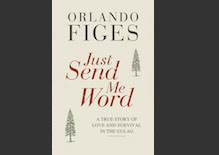|

The terrible conflict that dominated the mid 19th century, the Crimean War killed at least a million men and pitted Russia against a formidable coalition of Britain, France and the Ottoman Empire. It was a war for territory, provoked by fear that if the Ottoman Empire were to collapse then Russia could control a huge swathe of land from the Balkans to the Persian Gulf. But it was also a war of religion, driven by a fervent, populist and ever more ferocious belief by the Tsar and his ministers that it was Russia’s task to rule all Orthodox Christians and control the Holy Land.
Orlando Figes’ major new book reimagines this extraordinary war, in which the stakes could not have been higher and which was fought with a terrible mixture of ferocity and incompetence. It was both a recognisably modern conflict, the first to be extensively photographed, the first to employ the telegraph, the first ‘newspaper war’ and a traditional one, with illiterate soldiers, amateur officers and huge casualties caused by disease.
The iconic moments of the war—the Charge of the Light Brigade, the Siege of Sebastapol, the impact of Florence Nightingale—are all here but there is also a rich sense of the Crimea itself and the culture that was destroyed by the fighting. Drawing on a huge range of fascinating sources, Figes also gives the lived experience of the war, from that of the ordinary British soldier in his snow-filled trench, to the haunted, gloomy, narrow figure of Tsar Nicholas himself as he vows to take on the whole world in his hunt for religious salvation.
Extract from the Introduction:
There are many books in English on the Crimean War. But this is the first in any language to draw extensively from Russian, French and Ottoman as well as British sources to illuminate the geo-political, cultural and religious factors that shaped the involvement of each major power in the conflict. Because of this concentration on the historical context of the war, readers eager for the fighting to begin will need to be patient in the early chapters (or even skip overt them). What I hope emerges from these pages is a new appreciation of the war's importance as a major turning-point in the history of Europe, Russia and the Middle East, the consequences of which are still felt today. There is no room here for the widespread British view that it was a 'senseless' and 'unnecessary' war - an idea going back to the public's disappointment with the poorly managed military campaign and its limited achievements at the time - which has since had such a detrimental impact on the historical literature. Long neglected and often ridiculed as a serious subject by scholars, the Crimean War has been left mainly in the hands of British military historians, many of them amateur enthusiasts, who have constantly retold the same stories (the Charge of the Light Brigade, the bungling of the English commanders, Florence Nightingale) with little real discussion of the war's religious origins, the complex politics of the Eastern Question, Christian-Muslim relations in the Black Sea region, or the influence of European Russophobia, without which it is difficult to grasp the conflict's true significance.
Extract from Chapter 1:
For weeks the pilgrims had been coming to Jerusalem for the Easter festival. They came from every corner of Eastern Europe and the Middle East, from Egypt, Syria, Armenia, Anatolia, the Greek peninsula, but most of all from Russia, travelling by sea to the port of Jaffa where they hired camels or donkeys. By Good Friday, on 10 April 1846, there were 20,000 pilgrims in Jerusalem. They rented any dwelling they could find or slept in family groups beneath the stars. To pay for their long journey nearly all of them had brought some merchandise, a hand-made crucifix or ornament, strings of beads or pieces of embroidery, which they sold to European tourists at the holy shrines. The square before the Church of the Holy Sepulchre, the focus of their pilgrimage, was a busy market-place, with colourful displays of fruits and vegetables competing for space with pilgrims' wares and the smelly hides of goats and oxen left out in the sun by the tanneries behind the church. Beggars too collected here. They frightened strangers into giving alms by threatening to touch them with their leprous hands. Wealthy tourists had to be protected by their Turkish guides, who hit the beggars with heavy sticks to clear a path to the church doors.
In 1846, Easter fell on the same date in the Latin and Greek Orthodox calendars, so the holy shrines were much more crowded than usual, and the mood was very tense. The two religious communities had long been arguing about who should have first right to carry out their Good Friday rituals on the altar of Calvary inside the Church of the Holy Sepulchre, the spot where the cross of Jesus was supposed to have been inserted in the rock. During recent years, the rivalry between the Latins and the Greeks had reached such fever pitch that Mehmet Pasha, the Ottoman governor of Jerusalem, had been forced to position soldiers inside and outside the church to preserve order. But even this had not prevented fights from breaking out.
On this Good Friday, the Latin priests arrived with their white linen altar-cloth to find that the Greeks had got there first with their silk embroidered cloth. The Catholics demanded to see the Greeks' firman, their decree from the sultan in Constantinople, empowering them to place their silk cloth on the altar first. The Greeks demanded to see the Latins' firman allowing them to remove it. A fight broke out between the priests, who were quickly joined by monks and pilgrims on either side. Soon the whole church was a battlefield. The rival groups of worshippers fought not only with their fists, but with crucifixes, candlesticks, chalices, lamps and incense-burners, and even bits of wood which they tore from the sacred shrines. The fighting continued with knives and pistols smuggled into the Holy Sepulchre by worshippers of either side. By the time the church was cleared by Mehmet Pasha's guards, more than forty people lay dead on the floor.
Crimea was published in 2010 to critical acclaim:
Oliver Bullough in The Independent:
'This is the only book on the Crimean War anyone could need. It is lucid, well-written, alive and sensitive. Above all, it tells us why this neglected conflict and its forgotten victims deserve our remembrance.'
Angus Macqueen in The Observer:
'This fine writer and ambitious historian is back doing what he does best - telling us things about Russia and the world that we did not know, and proving that they are important to our understanding of the world today….With his deep understanding of Russia and its uncomfortable position in the world, Figes elegantly underlines how the cold war of the Soviet era froze over fundamental fault lines that had opened up in the 19th century.'
|







